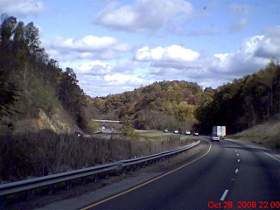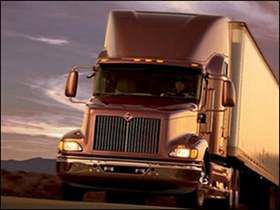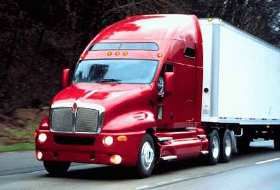Humbled By Shifting.... :)
Topic 1986 | Page 2

Bonarro, Check out this YouTube video on double clutching the best I've seen.
How To Double Clutch A Tractor Trailer This is an explanation about how to double clutch shift a tractor trailer
Thank You so much for that.
Double Clutch:
To engage and then disengage the clutch twice for every gear change.
When double clutching you will push in the clutch, take the gearshift out of gear, release the clutch, press the clutch in again, shift the gearshift into the next gear, then release the clutch.
This is done on standard transmissions which do not have synchronizers in them, like those found in almost all Class A trucks.
Double Clutching:
To engage and then disengage the clutch twice for every gear change.
When double clutching you will push in the clutch, take the gearshift out of gear, release the clutch, press the clutch in again, shift the gearshift into the next gear, then release the clutch.
This is done on standard transmissions which do not have synchronizers in them, like those found in almost all Class A trucks.

What I learned is that no one was born knowing how to shift a tractor. When shifting a truck, you’re doing things you’ve never done before so it will take a little time to get the timing down and everything in sync, so be kind to yourself, and don’t compare yourself to anyone else. Even if it takes you a little longer than someone else it doesn’t mean you won’t be as good at it in the end as the person who picked it quicker.
I’ve always thought to myself, for upshifting, CLUTCH/ NEUTRAL; CLUTCH/ SHIFT. For downshifting, CLUTCH/ NEUTRAL; CLUTCH/ REV/ SHIFT. Once you get it you’ll wonder why you were having trouble because it will seem so easy to do.
OWI:
Operating While Intoxicated
I can tell you that in time shifting WILL become second nature, and when it grinds occasionally (it WILL happen), you will instinctively get it into gear and not panic. I even float the gears on my car now. The first time I did it without thinking, I realized what I did and popped it out of gear real quick, then I realized, hey, I just floated it into gear! Also, sometimes I leave the jake brake on in the truck without realizing it, and then when I notice it I am amazed I had been driving/shifting it with the brake on and didn't even realize it.
I typically float the gears when shifting up, and double-clutch when down-shifting. That just seems to work for me. I will downshift without the clutch occasionally, when I "feel" it will go smoothly. You'll get the hang of it!
One thing that helped me was I realized shifting goes smoother if you don't wait until the RPM's are all the way up to 1500. I tend to shift at slower rpm's now, and it works better. Don't get me wrong, sometimes I go higher, but shifting seems a lot easier at lower rpm's. Also, shifting quicker on the lower gears and a little slower as you shift up seems to help. You can "feel" it slip into gear. It probably wouldn't hurt to float a gear or two, just to see how it works, then you know the timing that will work best for double-clutching. Also, I have noticed that simply pushing the clutch in an inch and holding it there doesn't work as well as if you shift while "moving" the clutch a little. In other words, I might push the clutch in a little when taking it out of gear, leave it there, then let it out just a little then press it in a little further going into the next gear. Also, the friction point is different in different trucks, and a lot of trucks I've driven you really have to mash the clutch all the way down to engage the clutch brake. One truck in school you had to push the clutch almost to the floor to shift, and others you only have to push it in about an inch. You can "feel" it by just pulling a little on the shifter, pressing in the clutch, and feel when it pops out. "Pumping" the clutch a little (not to the floor!) always seems to help me get it in gear if I am a little off.
One little exercise I found myself doing it when creeping along in construction traffic. Barely accelerating and then slipping into the next gear, or barely tapping the accelerator and slipping it down a gear. Basically, for me, I found that downshifting seems to work if I start to put it into the gear about the same time I push the accelerator a little. Revving it all the way up to 1500 and trying to catch it just never worked well for me. This seems to work better at about 1250 ... of course, if the rpm's are too high when you downshift then you have to rev it up to catch the gear... which is why shifting at lower rpm's seems to work better. It's also easier to "feel" when it's time to put it in gear instead of "missing" it because the rpm's are going up or down too fast.
I might just be imagining all this, but it seems to work for me. Hope I didn't make things worse!
Input from veterans is welcome!
Float The Gears:
An expression used to describe someone who is shifting gears without using the clutch at all. Drivers are taught to "Double Clutch" or press and release the clutch twice for each gear shift. If you're floating gears it means you're simply shifting without using the clutch at all.

You are doing what every truck driver has done. Brett and Old School hit it on the head.
Just relax. I drive a 4x4 because I have driven a truck so much I hate to ride low. Drove my sisters Toyota a few months ago and was scarred to death. I couldn't see a thing. Past the exit ramp for home coming from the airport and felt like that Braves baseball player driving I-285 for three days.
Forget what you do in a car. This is a TRUCK. But you my friend can do it. Just think 1, 2...1, 2....1, 2. Just faster. Or slower depending on the gear displacement. Some trucks are fast others are slow. Put one of those kitchen sponges under your foot while at home. Feel how the sponge goes back into place. That is what you should be feeling when shifting. And keep your heel on the floorboard. Adjust that seat as much as you need to to get comfortable.
Good luck.
HOS:
Hours Of Service
HOS refers to the logbook hours of service regulations.
Awesome video and awesome description. I have tried floating the gears in my 4-wheeler. I had a 50/50 grind ratio, but it was possible.

I can't express how much I appreciate it. I know I'm putting excess pressure on myself. I really need this to work out. Like many Americans,my previous career in a bad economy has left me hanging by a thread financially
Hi Bonarro, everyone here had really great advice for you, so I just want to add a back pat. You'll be fine. I too have everything riding on this career change. After being out of work, paying for a portion of my CDL school and other expenses... I am all in as they say.
I drive a clutch too and my instructors told me that those of us who have driven clutch for years have the most changes to make, the most stuff to UN-LEARN. Stay with it. On graduation day you'll look back at day one and wonder why you were so distressed! 
CDL:
Commercial Driver's License (CDL)
A CDL is required to drive any of the following vehicles:
- Any combination of vehicles with a gross combined weight rating (GCWR) of 26,001 or more pounds, providing the gross vehicle weight rating (GVWR) of the vehicle being towed is in excess of 10,000 pounds.
- Any single vehicle with a GVWR of 26,001 or more pounds, or any such vehicle towing another not in excess of 10,000 pounds.
- Any vehicle, regardless of size, designed to transport 16 or more persons, including the driver.
- Any vehicle required by federal regulations to be placarded while transporting hazardous materials.
HOS:
Hours Of Service
HOS refers to the logbook hours of service regulations.
Bonarro, Check out this YouTube video on double clutching the best I've seen.
How To Double Clutch A Tractor Trailer This is an explanation about how to double clutch shift a tractor trailer


O M G ... I've been wondering all this time, what the heck you all mean by clutch. I tried to visualize it in terms of how I drive my automatic transmission car. What I've discovered, after watching this EXCELLENT video, is that I'll have to COMPLETELY relearn how to drive. Driving a 18-wheeler means I'll have to drive with BOTH FEET - ALL THE TIME. This terrifies me. Your coordination has to be perfect. I'm right-handed and drive with my right foot only. I hope that by the time I get to truck driving school, I won't feel this way, and I hope I get a really patient trainer.
Double Clutch:
To engage and then disengage the clutch twice for every gear change.
When double clutching you will push in the clutch, take the gearshift out of gear, release the clutch, press the clutch in again, shift the gearshift into the next gear, then release the clutch.
This is done on standard transmissions which do not have synchronizers in them, like those found in almost all Class A trucks.
Double Clutching:
To engage and then disengage the clutch twice for every gear change.
When double clutching you will push in the clutch, take the gearshift out of gear, release the clutch, press the clutch in again, shift the gearshift into the next gear, then release the clutch.
This is done on standard transmissions which do not have synchronizers in them, like those found in almost all Class A trucks.

Since the thread has been necro'd, thought I'd share what I experienced.
I've driven various standard vehicles since driving age (about 10 years old). Thought I'd have no problems since, I have driven a cement mixer truck (they called it bulk trucks) and a trash compactor truck sometimes when I worked for a boat manufacturer. Those all had standard transmissions and were no problem to me all.
First day behind the wheel on the semi and out on the shifting area, I COULD NOT EVEN GET INTO 3rd gear and we started in second!!!
You literally do have to forget all you have learned about shifting and relearn it. The instructor had told us all that people that have never driven a standard transmission at all would learn the fastest at shifting a semi. He was right.
So, what we had to do was go home and get a broom or mop handle and sit down in a kitchen chair and pretend we were shifting (with motor sounds and all) to get the rhythm down. You have to train your muscles to do it correctly. Also, we were told to wear regular shoes (not boots), so that we could feel the clutch better. These things helped tremendously. Yeah I know, the neighbors thought I'd finally lost all of my mind when they looked in my windows and saw me shifting a mop handle in the middle of the kitchen.
Think 1 one-thousand 2 one-thousand. That is about the timing you will need. Shift out, and shift in. Clutch in and out, clutch in and SLOWLY out. Those at about the speed in which you say them.
Downshifting is quite a bit different. You have to rev up the engine before you shift into the lower gear first.
Oh and don't fret it, it's just to pass the CDL driving test. Once you get working, you will need to float the gears anyway. And for that, you have to forget all that double clutching and learn how all over again from your trainer.
Most important, don't think you know it all. LISTEN to your trainer/teacher. Try to remember and put into practice what he/she is telling you. Try to forget all that you THINK should work.
Hope it helps.
CDL:
Commercial Driver's License (CDL)
A CDL is required to drive any of the following vehicles:
- Any combination of vehicles with a gross combined weight rating (GCWR) of 26,001 or more pounds, providing the gross vehicle weight rating (GVWR) of the vehicle being towed is in excess of 10,000 pounds.
- Any single vehicle with a GVWR of 26,001 or more pounds, or any such vehicle towing another not in excess of 10,000 pounds.
- Any vehicle, regardless of size, designed to transport 16 or more persons, including the driver.
- Any vehicle required by federal regulations to be placarded while transporting hazardous materials.
Float The Gears:
An expression used to describe someone who is shifting gears without using the clutch at all. Drivers are taught to "Double Clutch" or press and release the clutch twice for each gear shift. If you're floating gears it means you're simply shifting without using the clutch at all.
Double Clutch:
To engage and then disengage the clutch twice for every gear change.
When double clutching you will push in the clutch, take the gearshift out of gear, release the clutch, press the clutch in again, shift the gearshift into the next gear, then release the clutch.
This is done on standard transmissions which do not have synchronizers in them, like those found in almost all Class A trucks.
Double Clutching:
To engage and then disengage the clutch twice for every gear change.
When double clutching you will push in the clutch, take the gearshift out of gear, release the clutch, press the clutch in again, shift the gearshift into the next gear, then release the clutch.
This is done on standard transmissions which do not have synchronizers in them, like those found in almost all Class A trucks.
HOS:
Hours Of Service
HOS refers to the logbook hours of service regulations.Debbie, fret not. Yes, the switch from automatic transmission to just clutch shifting will be a bit, shall I say, shaky. But it's a motor skill thing, like riding a bike - once your body learns what to do, you won't have to think about it. But getting there is the problem.
You might hear about floating the gears - moving the shift lever between gears without using the clutch. Don't worry about that now, you need to double clutch to pass most driving exams.
Ken suggested "1 one-thousand 2 one-thousand" = that's two seconds. Way to much time in traffic. Learn with it on the driving/shifting range, but if you say out loud "bop - bop", that's the timing you should aim for. Also, don't worry about pushing the clutch pedal all the way to the floor while shifting. Just get it maybe half way down. As I said, your body will learn before your brain will.
You can look forward to a tractor with an automatic transmission, but in he mean time, put a pillow under your left foot when you practice with the broom stick.
Double Clutch:
To engage and then disengage the clutch twice for every gear change.
When double clutching you will push in the clutch, take the gearshift out of gear, release the clutch, press the clutch in again, shift the gearshift into the next gear, then release the clutch.
This is done on standard transmissions which do not have synchronizers in them, like those found in almost all Class A trucks.
New Reply:
New! Check out our help videos for a better understanding of our forum features

















Preview:
This topic has the following tags:
Safe Driving Tips Tips For Shifting







 TT On Facebook
TT On Facebook
That's funny that you mentioned it. I got in my S-10 after class and forgot how to drive it.